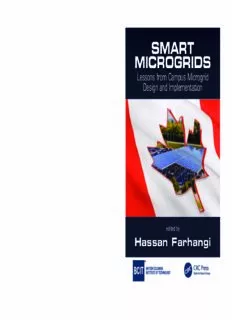
Smart microgrids: lessons from campus microgrid design and implementation PDF
Preview Smart microgrids: lessons from campus microgrid design and implementation
SMART SMART MICROGRIDS MICROGRIDS Lessons from Campus Microgrid Lessons from Campus Microgrid Design and Implementation Design and Implementation Summary The utility sector’s transition to renewable energy and the smart grid has already begun. The first step towards smart grid is microgrid, which is a smaller electricity grid with access to all the essential assets of a larger grid. This book provides a glimpse into an actual microgrid project. It supplies a system-level approach to the design of smart microgrids, covering the entire design process—from road- map to realization. Detailing lessons learned and pitfalls to avoid in microgrid technology, the book provides an interdisciplinary approach to design and problem solving for smart microgrids. Features • Provides a system-level approach to the design of smart microgrids • Covers the entire design process from roadmap to realization • Captures lessons learned and pitfalls to avoid in microgrid technology • Presents an interdisciplinary approach to design and problem solving for smart microgrid edited by • Supplies a firsthand account of a successful campus based on microgrid Hassan Farhangi K23688 ISBN: 978-1-4822-4876-0 90000 9 781482 248760 K23688_Cover_PubGr.indd All Pages 7/18/16 11:39 AM SMART MICROGRIDS Lessons from Campus Microgrid Design and Implementation SMART MICROGRIDS Lessons from Campus Microgrid Design and Implementation edited by Hassan Farhangi British Columbia Institute of Technology Vancouver, Canada Boca Raton London New York CRC Press is an imprint of the Taylor & Francis Group, an informa business CRC Press Taylor & Francis Group 6000 Broken Sound Parkway NW, Suite 300 Boca Raton, FL 33487-2742 © 2017 by Taylor & Francis Group, LLC CRC Press is an imprint of Taylor & Francis Group, an Informa business No claim to original U.S. Government works Printed on acid-free paper Version Date: 20160707 International Standard Book Number-13: 978-1-4822-4876-0 (Hardback) This book contains information obtained from authentic and highly regarded sources. Reasonable efforts have been made to publish reliable data and information, but the author and publisher cannot assume responsibility for the validity of all materials or the consequences of their use. The authors and publishers have attempted to trace the copyright holders of all material reproduced in this publication and apologize to copyright holders if permission to publish in this form has not been obtained. If any copyright material has not been acknowledged please write and let us know so we may rectify in any future reprint. Except as permitted under U.S. Copyright Law, no part of this book may be reprinted, reproduced, transmitted, or utilized in any form by any electronic, mechanical, or other means, now known or hereafter invented, including photocopying, microfilming, and recording, or in any information stor- age or retrieval system, without written permission from the publishers. For permission to photocopy or use material electronically from this work, please access www.copy- right.com (http://www.copyright.com/) or contact the Copyright Clearance Center, Inc. (CCC), 222 Rosewood Drive, Danvers, MA 01923, 978-750-8400. CCC is a not-for-profit organization that pro- vides licenses and registration for a variety of users. For organizations that have been granted a photo- copy license by the CCC, a separate system of payment has been arranged. Trademark Notice: Product or corporate names may be trademarks or registered trademarks, and are used only for identification and explanation without intent to infringe. Visit the Taylor & Francis Web site at http://www.taylorandfrancis.com and the CRC Press Web site at http://www.crcpress.com Disclaimer This book was prepared as the result of research conducted by British Columbia Institute of Technology (BCIT) and its partners. Nevertheless, it does not necessarily represent the views of BCIT, its partners, or the funding agencies that have funded this work. As such, BCIT, its employees, contractors, and subcontractors make no warrant, express or implied, and assume no legal liability for the information in this book; nor does any party represent that the uses of this information will not infringe upon privately owned rights. This book has not been approved or disapproved by BCIT, nor has BCIT certified the accuracy or adequacy of the information in this book. Moreover, the information contained in this book is subject to future revisions. Important notes of limitations include the following: this book is not a replacement for electrical codes or other applicable standards; this book is not intended or provided by BCIT as design specification or as design guidelines for electrical installations; and the book shall not be used for any purpose other than education and training. Persons using this information do so at no risk to BCIT, and they rely solely upon themselves to ensure that their use of all or part of this book is appropriate in the particular circumstance. Yesterday I was young, so I wanted to change the world. Today I am wise, so I am changing myself. Rumi Dedicated to all those who strive to better the life of others by being better human beings themselves and who have the wisdom to strike a balance between progress and keeping this lonely planet habitable for the future generations. … and to Sara and Aras Contents Foreword xi PreFace xiii acknowledgments xvii editor xix contributors xxi list oF abbreviations xxv chaPter 1 microgrid as the building block oF smart grid 1 HASSAN FARHANGI chaPter 2 smart grid system integration 31 HASSAN FARHANGI chaPter 3 camPus microgrid 65 HASSAN FARHANGI chaPter 4 cogeneration Plants 95 MINOO SHARIAT-ZADEH chaPter 5 electrical storage system 131 ERIC HAWTHORNE ix
Description: